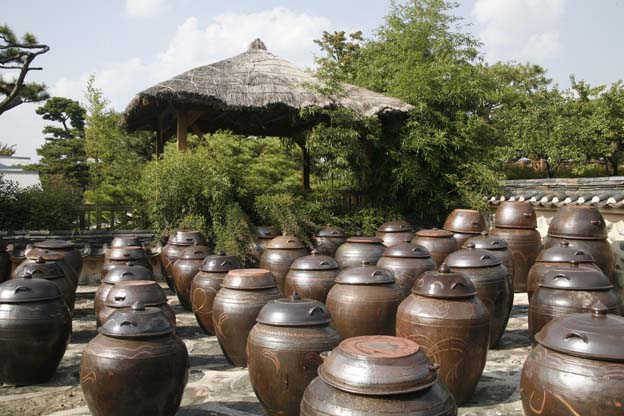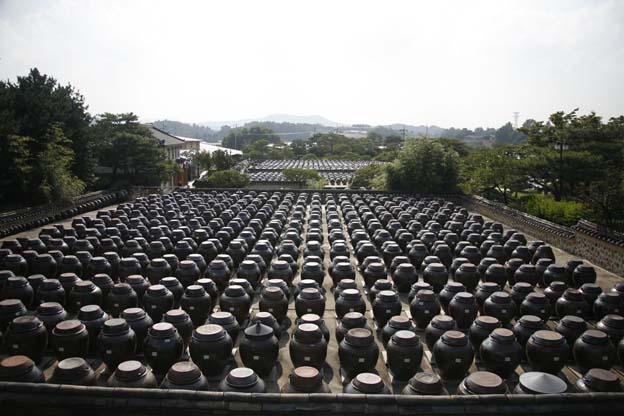Although not worth a special trip on its own, if you happen to be visiting Anseong, stop in at the Seoilnong-won. It’s an old-fashioned farm that’s been updated for visitors to see how “dwenjang,” Korea’s fermented soybean paste is made. And they do it the old-fashioned way.
The traditional way of making dwenjang was to take dried soybeans, boil them, then grind them with a large stone mill into coarse bits. Then, the paste is formed into bricks called “meju” and left to dry (the air circulation helps with the fermentation process). A couple of months later (depending on the size of the meju), the meju and some added birne are put into large brown pots (hang-alli) and left covered in the sunlight to ferment further. The pottery allowed for a bit of circulation of air, while keeping bugs and other undesirables away.
When the fermentation process is complete, the liquid and solids are separated. The liquid becomes Korean soy sauce (ganjang) and the solids make dwenjang. Although Korean soybean paste is often compared to Japanese miso, dwenjang is chunkier and has bits of soybean in it. It’s actually more akin to the Chinese dajiang, popular in Northeastern Chinese provinces.
Dwenjang can be eaten as a dip with fresh vegetables (like carrots, cucumber and green chile peppers) or used to make a salty stew, called “dwenjang jjigae.” You might have seen a side of seasoned dwenjang to add to your meat and lettuce wrap at your favorite Korean barbecue restaurant.
At the Seoilnong-won are some old farm implements, a well and a small pear orchard. But the big draw are the rows and rows of dark-brown hang-alli filled with the dwenjang, hanging out in the sunlight.
The best time to visit is on a Saturday (April-October) when Anseong Namsadang Nori offer free performances all day at the nearby village.


Did you try any of the dwenjang?
I didn’t, unfortunately! I was driving all around the countryside and I didn’t want to drive around for weeks with a stinky jar of dwenjang in the trunk. But I hope to go back during lunch hour when they have the restaurant open.
Hi there – I bought your cookbook while vacationing in Maui last year and brought it home with me to LA. Since then I’ve been cooking pretty madly with it and wanted to tell you how much I’ve enjoyed the recipes! Your recipes have made cooking Korean at home much less intimidating for me. I’ve probably tried at least a third of the recipes and each has turned out well. Just this morning I finished making my second batch of the cabbage kimchee. I also just bought my first dolsot (sp?) this weekend. Yay! Being Chinese it’s nice to be able to occasionally blend some of the Korean dishes with Chinese to round out a meal or just make it more interesting. Thanks so much for creating this cookbook, I know we’ll be enjoying it for a long time. I hope there will be another soon!
If I sound a little bit like a crazed fan please forgive me, but there is a true lack of Korean cookbooks for the English-speaking world.
Hi Yuan,
I’m so glad you’re enjoying my cookbook. I DID write it as an introductory tome for people to not be intimidated about cooking Korean food in their home kitchens, so I’m happy to hear that it’s doing what I set out to do. I hope to write more Korean cookbooks in the future, since I’m one of the few people in the world that can write in English and cook Korean food.
My next cookbook (which is coming out in 2011) is Quick and Easy Mexican Cooking, so if you’re interested in trying your hand at Latin flavors, I hope you’ll check it out, too (I just turned in the manuscript but it takes my publisher a year to do design, try out the recipes, photograph them etc.)
You’ll have to share with me some Chinese dishes, too.
Thanks!